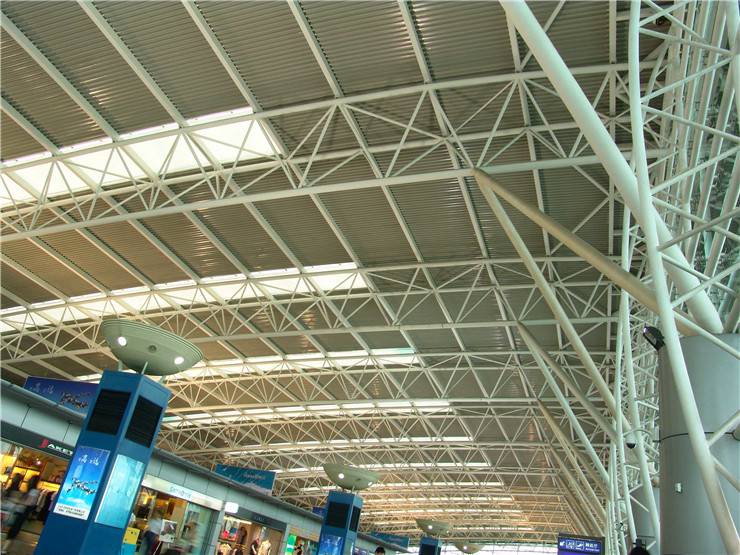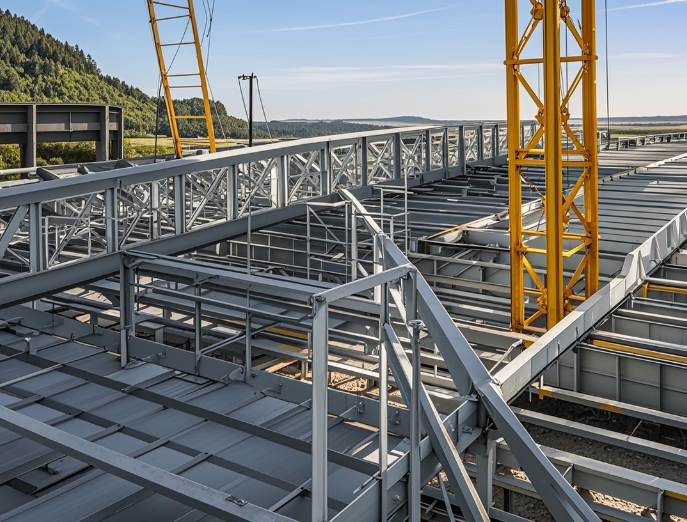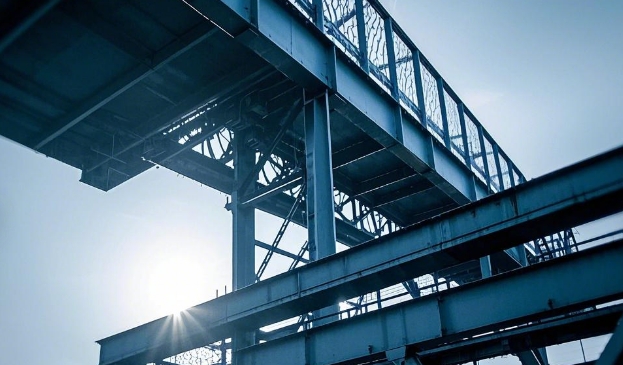Design requirements for grid steel structures
更新时间:2025-02-20 15:22:59•点击:6111539 • Entreprise's news

In the modern construction industry, grid steel structures have been widely used in various large buildings such as sports venues, exhibition halls, and industrial plants due to their significant advantages of high strength, light weight, and strong spatial adaptability. Strict and comprehensive design requirements are essential to ensure the safety, stability, and efficiency of grid steel structures in practical use, and to meet the requirements of various complex working conditions.
Structural selection and layout: laying the foundation for design
Structural selection and layout are the primary steps in the design of truss steel structures, playing a decisive role. When selecting, it is necessary to comprehensively consider various factors such as the building's functional use, planar shape, span size, building height, and the type and size of the load it can withstand. For example, the planar truss system is suitable for buildings with large planar dimensions and aspect ratios. Its structural form can effectively transfer loads along the truss, fully utilizing the mechanical properties of the material; The square pyramid system grid is commonly used for square or nearly square planes. This grid form has good spatial stress performance, can evenly distribute loads, and improve the stability of the structure.
When arranging the structure, it is necessary to ensure that the force transmission path of the structure is clear, direct, and uniform, and to avoid stress concentration, as stress concentration may cause premature failure of local structures, affecting the safety of the overall structure. In addition, setting the arch height reasonably is also crucial. By accurately calculating and setting the arch, the deflection of the structure under long-term load can be effectively reduced, ensuring the functional and aesthetic requirements of the building.
Accurate load calculation: the key to ensuring structural safety
Load calculation is a crucial step in the design of truss steel structures, directly related to the safety and economy of the structure. The dead load mainly includes the structural weight of the grid itself, the weight of the roof covering material, and the weight of ancillary facilities such as suspended ceilings. When calculating the dead load, it is usually possible to first make preliminary estimates through empirical formulas, and then combine detailed structural design and material parameters for accurate calculations to ensure the accuracy of the dead load calculation.
The live load is determined strictly according to the relevant building structural load specifications based on the specific functional use of the building. For example, the live load on the roof of a building is generally between 2.0kN/m ² and 3.5kN/m ² to meet the load-bearing requirements for personnel activities and temporary storage of items; The calculation of snow load and wind load needs to refer to local meteorological data and terrain conditions, and accurately calculate according to the calculation formulas in the specifications, fully considering the climate characteristics and terrain effects of different regions.
In some special cases, such as buildings located in earthquake prone areas or industrial buildings with heavy equipment such as cranes operating, special loads such as seismic effects, ash accumulation loads, and crane loads also need to be considered. The effects of these special loads often have suddenness and complexity, and have a significant impact on the structure. Therefore, sufficient attention must be given in the design to conduct detailed analysis and calculations.
Rod and Node Design: The Core of Structural Safety
Members and nodes are the basic components of grid steel structures, and their design directly affects the safety performance of the entire structure. The cross-sectional forms of rods are diverse and rich, commonly including round steel pipes, high-frequency welded thin-walled H-beams, etc. When selecting the cross-sectional dimensions of a member, precise calculations need to be made based on the internal forces that the member is subjected to. For tension rods, the cross-sectional dimensions are mainly determined based on strength conditions to ensure that the rod does not break or fail under tension; For compression members, in addition to meeting strength requirements, it is also necessary to fully consider the limitations of stability and aspect ratio to prevent buckling and instability of the members under pressure, which will affect the overall stability of the structure.
As a key component of connecting rods, the design of nodes is crucial. Common forms of nodes include welded ball nodes, bolted ball nodes, etc. Welded ball joints have the advantages of firm connection and good integrity, and are suitable for various complex grid structures; Bolt ball joints have the characteristics of easy installation and fast construction speed, and are widely used in projects that require high construction progress. The core goal of node design is to ensure that nodes can reliably transmit internal forces between members under various loads without damage or excessive deformation. This requires detailed mechanical analysis and calculations to determine the reasonable size, construction form, and connection method of the nodes, ensuring that the load-bearing capacity of the nodes meets the design requirements.
Seismic, fire and anti-corrosion design: enhancing structural durability and safety
In terms of seismic design, reasonable seismic fortification requirements need to be determined based on factors such as the seismic fortification category of the building, site conditions, and the seismic intensity of the location. For buildings of different seismic fortification categories, corresponding seismic strengthening measures should be taken, such as setting up effective support systems to enhance the lateral stiffness and stability of the structure; Strengthen the strength and ductility of node connections to ensure that nodes do not fail under earthquake action, enabling the structure to effectively dissipate seismic energy.
Fire protection design is also an important aspect that cannot be ignored in the design of truss steel structures. According to the fire resistance rating requirements of the building, appropriate fire protection measures should be selected, such as spraying fireproof coatings. The thickness and performance of fireproof coating should be accurately calculated and selected according to the fire resistance limit requirements of the structure, to ensure that in the event of a fire, the truss steel structure can maintain the integrity and bearing capacity of the structure within the specified time, and to save valuable time for personnel evacuation and firefighting rescue.
Anti corrosion design is equally crucial, as steel is susceptible to corrosion in natural environments, thereby reducing the strength and durability of the structure. Usually, anti-corrosion measures such as surface coating with anti rust paint and hot-dip galvanizing are adopted. Based on the environmental conditions and usage requirements of the structure, the thickness and maintenance period of the anti-corrosion coating are reasonably determined. Regular anti-corrosion maintenance is carried out on the structure to extend the service life of the grid steel structure.
Stability and fatigue design: ensuring long-term performance of the structure
Stability design includes two aspects: overall stability and local stability. The overall stability analysis usually adopts the finite element method, fully considering the geometric nonlinearity and material nonlinearity characteristics of the structure, simulating the stress state of the structure under various load conditions, and ensuring that the structure does not experience overall instability under the most unfavorable load combination. Local stability is mainly verified for members and nodes to prevent buckling or damage in local areas, which may affect the overall performance of the structure.
For grid steel structures that bear dynamic loads, such as crane beam systems in industrial plants, large-span bridges, etc., fatigue design is the key to ensuring the long-term safe operation of the structure. Fatigue design first requires accurate calculation of fatigue loads. Based on the usage and load characteristics of the structure, the magnitude and frequency of fatigue loads should be determined according to relevant specifications. Then, fatigue strength verification is carried out on key members and nodes in the structure. By selecting materials reasonably, optimizing structural construction and connection methods, and other measures, the fatigue resistance performance of the structure is improved to ensure that it can withstand repeated loads during the design service life without fatigue failure.
In addition, it is necessary to strictly control the deformation and deflection of the grid structure under load, so as to meet relevant specifications and practical usage requirements. Excessive deformation and deflection not only affect the functional use of the building, but may also lead to redistribution of internal forces in the structure, endangering structural safety. Effective control of deformation and deflection can be achieved through measures such as increasing the cross-sectional size of the members, optimizing the form of the grid structure, and setting pre camber.
The design requirements of the grid steel structure run through various stages of the entire design process, and each stage is interrelated and influences each other, together forming a complete design system. Only by strictly following these design requirements and conducting comprehensive, meticulous, and scientific design can we ensure that the advantages of the grid steel structure are fully utilized in buildings, achieve safe, stable, economical, and aesthetically pleasing building goals, and provide reliable building space for people.
Recommended Reading
-
Full analysis of seismic design and maintenance of grid structure
2025-02-27 16:16:52•1197136 次
-
What are the key process points to follow in order to ensure the quality of grid processing?
2025-02-27 11:21:00•115712 次
-
What type of construction is the grid mainly suitable for?
2025-02-25 16:42:00•111899 次
-
Quality control requirements of grid manufacturers!
2025-02-25 16:02:44•208066 次






